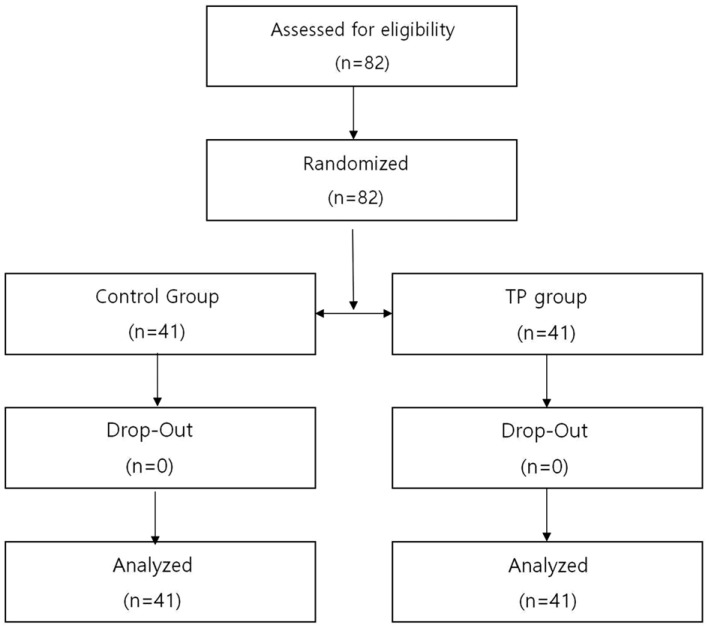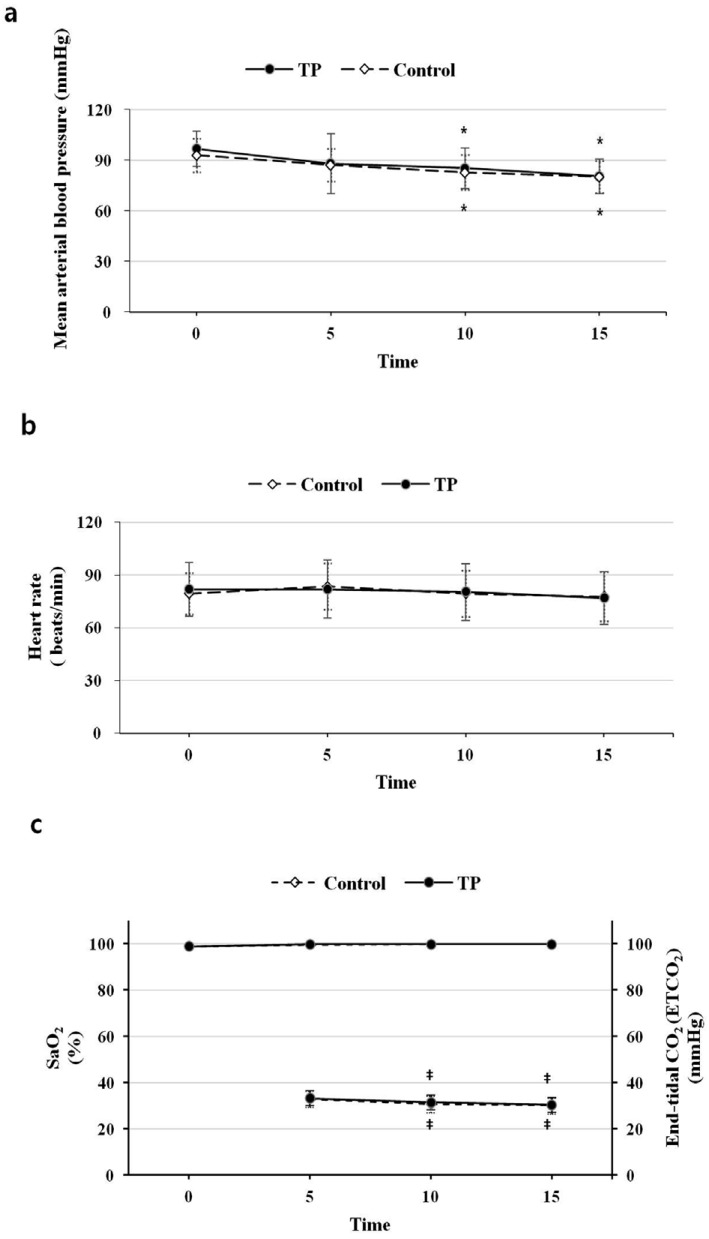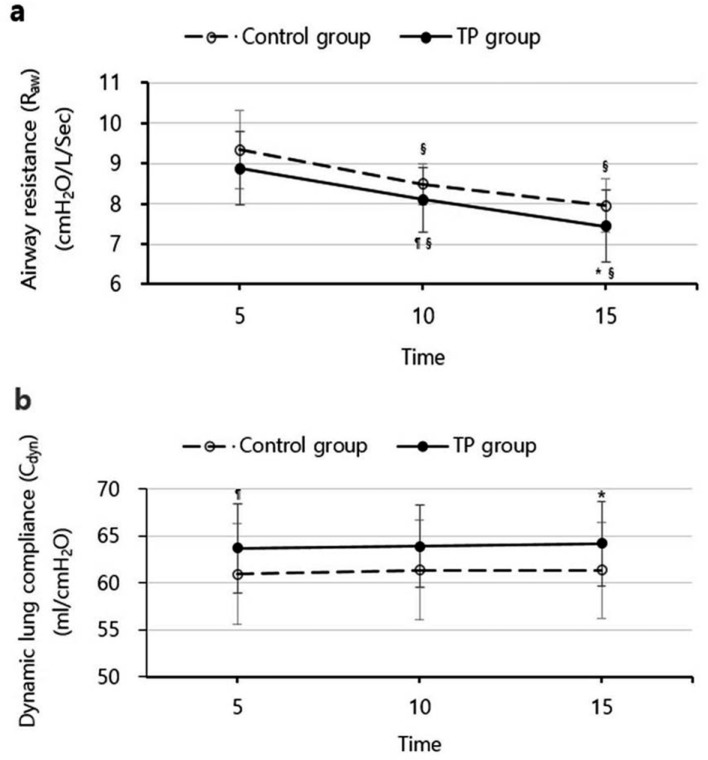J Dent Anesth Pain Med.
2017 Dec;17(4):265-270. 10.17245/jdapm.2017.17.4.265.
The effect of tulobuterol patches on the respiratory system after endotracheal intubation
- Affiliations
-
- 1Department of Anesthesia and Pain Medicine, Biomedical Research Institute, Pusan National University Hospital, Busan, Republic of Korea. eunsookim@pusan.ac.kr
- 2Department of Dental Anesthesia and Pain Medicine, Pusan National University Dental Hospital, Dental Research Institute, Yangsan, Republic of Korea.
- KMID: 2399796
- DOI: http://doi.org/10.17245/jdapm.2017.17.4.265
Abstract
- BACKGROUND
Endotracheal intubation during anesthesia induction may increase airway resistance (R(aw)) and decrease dynamic lung compliance (Cdyn). We hypothesized that prophylactic treatment with a transdermal β2-agonist tulobuterol patch (TP) would help to reduce the risk of bronchospasm after placement of the endotracheal tube.
METHODS
Eighty-two American Society of Anesthesiologists (ASA) category I or II adult patients showing obstructive patterns were divided randomly into a control and a TP group (n = 41 each). The night before surgery, a 2-mg TP was applied to patients in the TP group. Standard monitors were recorded, and target controlled infusion (TCI) with propofol and remifentanil was used for anesthesia induction and maintenance. Simultaneously, end-tidal carbon dioxide, R(aw), and Cdyn were determined at 5, 10, and 15 min intervals after endotracheal intubation.
RESULTS
There was no significant difference in demographic data between the two groups. The TP group was associated with a lower R(aw) and a higher Cdyn, as compared to the control group. R(aw) was significantly lower at 10 min (P < 0.05) and 15 min (P < 0.01), and Cdyn was significantly higher at 5 min (P < 0.05) and 15 min (P < 0.01) in the TP group. A trend towards a lower R(aw) was observed showing a statistically significant difference 5 min after endotracheal intubation (P < 0.01) in each group.
CONCLUSIONS
Prophylactic treatment with TP showed a bronchodilatory effect through suppressing an increase in R(aw) and a decrease in C(dyn) after anesthesia induction without severe adverse effects.
MeSH Terms
Figure
Reference
-
1. Olsson GL. Bronchospasm during anaesthesia. A computer-aided incidence study of 136,929 patients. Acta Anaesthesiol Scand. 1987; 31:244–252. PMID: 3577646.2. Pizov R, Brown RH, Weiss YS, Baranov D, Hennes H, Baker S, et al. Wheezing during induction of general anesthesia in patients with and without asthma. A randomized, blinded trial. Anesthesiology. 1995; 82:1111–1116. PMID: 7741285.3. Eames WO, Rooke GA, Wu RS, Bishop MJ. Comparison of the effects of etomidate, propofol, and thiopental on respiratory resistance after tracheal intubation. Anesthesiology. 1996; 84:1307–1311. PMID: 8669670.
Article4. Kil HK, Rooke GA, Ryan-Dykes MA, Bishop MJ. Effect of prophylactic bronchodilator treatment on lung resistance after tracheal intubation. Anesthesiology. 1994; 81:43–48. PMID: 8042809.
Article5. Kim ES, Bishop MJ. Endotracheal intubation, but not laryngeal mask airway insertion, produces reversible bronchoconstriction. Anesthesiology. 1999; 90:391–394. PMID: 9952142.
Article6. Fukuchi Y, Nagai A, Seyama K, Nishimura M, Hirata K, Kubo K, et al. Clinical efficacy and safety of transdermal tulobuterol in the treatment of stable COPD: an open-label comparison with inhaled salmeterol. Treat Respir Med. 2005; 4:447–455. PMID: 16336029.
Article7. Yoshihara S, Yamada Y, Abe T, Arisaka O. The use of patch formulation of tulobuterol, a long-acting beta2-adrenoreceptor agonist, in the treatment of severe pediatric asthma. Ann Allergy Asthma Immunol. 2006; 96:879–880. PMID: 16802779.8. Horiguchi T, Kondo R, Miyazaki J, Fukumokto K, Torigoe H. Clinical evaluation of a transdermal therapeutic system of the beta2-agonist tulobuterol in patients with mild or moderate persistent bronchial asthma. Arzneimittelforschung. 2004; 54:280–285. PMID: 15212190.9. Burioka N, Miyata M, Endo M, Fukuoka Y, Suyama H, Nakazaki H, et al. Alteration of the circadian rhythm in peak expiratory flow of nocturnal asthma following nighttime transdermal beta2-adrenoceptor agonist tulobuterol chronotherapy. Chronobiol Int. 2005; 22:383–390. PMID: 16021849.10. Uematsu T, Nakano M, Kosuge K, Kanamaru M, Nakashima M. The pharmacokinetics of the beta 2-adrenoceptor agonist, tulobuterol, given transdermally and by inhalation. Eur J Clin Pharmacol. 1993; 44:361–364. PMID: 8099880.11. Iikura Y, Uchiyama H, Akimoto K, Ebisawa M, Sakaguchi N, Tsubaki T, et al. Pharmacokinetics and pharmacodynamics of the tulobuterol patch, HN-078, in childhood asthma. Ann Allergy Asthma Immunol. 1995; 74:147–151. PMID: 7697473.12. Pauwels RA, Buist AS, Calverley PM, Jenkins CR, Hurd SS. GOLD Scientific Committee. Global strategy for the diagnosis, management, and prevention of chronic obstructive pulmonary disease. NHLBI/WHO Global Initiative for Chronic Obstructive Lung Disease (GOLD) Workshop summary. Am J Respir Crit Care Med. 2001; 163:1256–1276. PMID: 11316667.13. Hepner DL, Castells MC. Anaphylaxis during the perioperative period. Anesth Analg. 2003; 97:1381–1395. PMID: 14570656.
Article14. Postma DS, Kerstjens HA. Characteristics of airway hyperresponsiveness in asthma and chronic obstructive pulmonary disease. Am J Respir Crit Care Med. 1998; 158:S187–S192. PMID: 9817744.
Article15. Wajima Z, Shiga T, Imanaga K, Inoue T, Ogawa R. Effect of prophylactic bronchodilator treatment with i.v. carperitide on airway resistance and lung compliance after tracheal intubation. Br J Anaesth. 2006; 96:660–664. PMID: 16531446.
Article16. Rooke GA, Choi JH, Bishop MJ. The effect of isoflurane, halothane, sevoflurane, and thiopental/nitrous oxide on respiratory system resistance after tracheal intubation. Anesthesiology. 1997; 86:1294–1299. PMID: 9197298.
Article17. Goff MJ, Arain SR, Ficke DJ, Uhrich TD, Ebert TJ. Absence of bronchodilation during desflurane anesthesia: a comparison to sevoflurane and thiopental. Anesthesiology. 2000; 93:404–408. PMID: 10910489.18. Kabara S, Hirota K, Yoshioka H, Kudo T, Ishihara H, Matsuki A. Differential effects of thiopental on methacholine- and serotonin-induced bronchoconstriction in dogs. Br J Anaesth. 2003; 91:379–384. PMID: 12925478.19. Nishiyama T, Hanaoka K. Propofol-induced bronchoconstriction: two case reports. Anesth Analg. 2001; 93:645–646. PMID: 11524333.
Article20. Sparr HJ, Beaufort TM, Fuchs-Buder T. Newer neuromuscular blocking agents: how do they compare with established agents? Drugs. 2001; 61:919–942. PMID: 11434449.21. Kume H, Kondo M, Ito Y, Suzuki R, Yamaki K, Takagi K. Effects of sustained-release tulobuterol on asthma control and beta-adrenoceptor function. Clin Exp Pharmacol Physiol. 2002; 29:1076–1083. PMID: 12390295.
Article22. Musoh K, Kawamura K, Miyake I, Shimada S, Ohashi T, Iwanaga Y, et al. The effect of tulobuterol tape on histamine-induced bronchoconstriction in conscious guinea pigs: long duration of action. Jpn J Pharmacol. 1999; 79:401–402. PMID: 10230871.23. Leff AR. Identifying patients at risk from the use of beta-adrenergic agonists. Am J Respir Crit Care Med. 1996; 154:1593. PMID: 8970339.
Article
- Full Text Links
- Actions
-
Cited
- CITED
-
- Close
- Share
- Similar articles
-
- Circulatory Changes during Fiberoptic Endotracheal Intubation
- A Brief Report on the Endotracheal Tube Cytology of the Upper Respiratory Tract Carcinoma
- A Case of Bacterial Tracheitis Associated with Endotracheal Intubation and Corticosteroid
- Granulomas of the Vocal Cords Following Endotracheal Anesthesia - Case report
- Endotracheal Intubation Using Laryngeal Mask Airway in a Patient with a Difficult Airway: A case report




